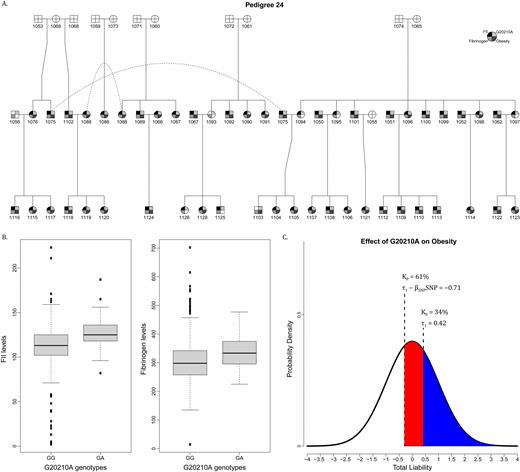Abstract
The literature on risk factors for venous thromboembolism (VTE) is replete with complex combinations of genetic and environmental determinants. Here we apply statistical genetic models to data from Mexican Americans of South Texas participating in the San Antonio Family Study (SAFS) to help disentangle some of this complexity. The SAFS has data for nearly 50 large extended pedigrees (Figure A) that are extensively phenotyped, especially for traits related to the pathophysiology of cardiovascular disease. Using a linear mixed model approach, while accounting for age, sex, and their interactions (including age-squared, age-by-sex, and age-squared-by-sex) as confounders, we found significant heritability for plasma FII (46%; N=640; p=6.9E-12) and fibrinogen (28%; N=759; p=1.6E-06) coagulant activity levels and that the Prothrombin G20210A mutation was significantly associated with both traits (FII: p=0.002; fibrinogen: p=0.037; Figure B). We also examined a dichotomous obesity variable based on the Adult Treatment Panel III criterion of sex-specific waist circumferences (>102 cm in males; >88 cm females) denoted as OBWC. Under a threshold and liability model, we found a significant heritability of the liability of OBWC (71%; N=654; p=4.4E-08) and that Prothrombin G20210A was a significant predictor (p=0.031), while still adjusting for age, sex, and their interactions. As can be seen in Figure C, the G20210A mutation profoundly impacts the liability of OBWC such that obesity prevalence, where the prevalence parameter is denoted by Kp in the figure, increases by 27% from individuals homozygous for the major G-allele (G/G) with a prevalence of 34% to heterozygous (G/A) individuals with a prevalence of 61%. To the best of our knowledge, this appears to be the largest single-allele-dose effect for obesity reported in the literature. We next performed bivariate trait analysis (each time accounting for age, sex, and their interactions as confounders) to discover potentially meaningful correlations between the three traits of interest and to see if these would influence their association with G20210A. Under a bivariate model for any two traits, denoted as trait A and B say, the parameters of the following equation are estimated:
r_p(A,B) = r_g(A,B)*sqrt(h2_A)*sqrt(h2_B) + r_e(A,B)* sqrt(1-h2_A)*sqrt(1-h2_B),
where r_p(A,B), r_g(A,B), and r_e(A,B) respectively denote the phenotypic, genetic, and environmental correlation coefficients of A and B, and where h2_A and h2_B denote the trait heritabilities. Moreover, we can test their significance using likelihood-based inferential statistics. For the FII and OBWC bivariate analysis, none of the correlation coefficients were significant. For the fibrinogen and OBWC bivariate analysis, we found significant phenotypic (r_p=0.24; p=2.0E-05) and genetic (r_g=0.41; p=0.024) correlations. For the FII and fibrinogen bivariate analysis, we found significant phenotypic (r_p=0.26; p=3.1E-10) and environmental (r_e=0.28; p=0.003) correlations. For all bivariate analyses, the Prothrombin G20210A mutation was always a significant predictor for both traits of any given pair. In conclusion, Prothrombin G20210A is pleiotropically associated with plasma FII and fibrinogen coagulant activity levels, and OBWC, and profoundly impacts the prevalence of obesity in our sample. The associations of the prothrombin G20210A mutation are not affected by the consideration of inter-correlations between the three traits examined and thus appears to be fairly robust.
DeFronzo: AstraZeneca: Membership on an entity's Board of Directors or advisory committees, Speakers Bureau; Novo Nordisk: Membership on an entity's Board of Directors or advisory committees; Boehringer-Ingelheim: Membership on an entity's Board of Directors or advisory committees, Research Funding; Intarcia: Membership on an entity's Board of Directors or advisory committees; Merck: Research Funding.


This feature is available to Subscribers Only
Sign In or Create an Account Close Modal